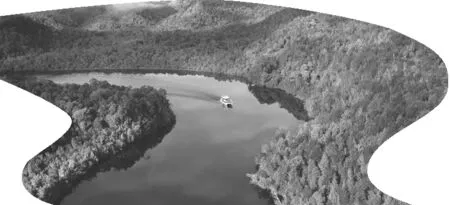塔斯马尼亚荒原
◎许林玉
塔斯马尼亚荒原是澳大利亚塔斯马尼亚岛上的一处保护区,也是澳大利亚最大的保护区之一,同时也是世界上最大的温带荒野之一,还是南半球仅存的三个温带荒原之一。一起来了解作为世界文化和自然双重遗产的塔斯马尼亚荒原吧!

入选时间(Date of Inscription) 1982 年遴选标准(Criteria) (iii)(iv)(vi)(vii)(viii)(ix)(x)占地面积(Property ) 1,584,233 公顷档案编号(Dossier) 181

The Tasmanian Wilderness is an area of1)remarkablenatural beauty and ecological diversity in southwestern, western, and central Tasmania, Australia. Designated a World Heritage site in 1982, its area was2)extendedto some 13,800 square km in 1989.
Most UNESCO World Heritage sites meet only one or two of the ten criteria. The Tasmanian Wilderness meets seven out of ten criteria.Only one other place on earth — China’s Mount Taishan — meets that many criteria.
The Tasmanian Wilderness consists3)largelyof Southwest National Park (established 1968), Franklin-Gordon Wild Rivers National Park(established 1981), and Cradle Mountain-Lake St. Clair National Park(established 1971), and it also includes Walls of Jerusalem National Park (established 1981) and Hartz Mountains National Park (established 1939). On its northeastern and eastern edges are the Central Plateau Conservation Area (established 1982) and other protected lands.Archaeological sites within the region are Maxwell River and Wargata Mina, and there is a historic site at Macquarie Harbour.
The Tasmanian Wilderness is a4)diverseAboriginal cultural landscape in which the cultural heritage of Tasmanian Aboriginal people is5)preserved.For tens of thousands of years Aboriginal people lived in the coastal environments, the valleys with freshwater rivers, open button grass plains and alpine mountains.
Aboriginal people have lived in, used, managed and modified the landscape of the Tasmanian Wilderness for at least 35,000 years. The physical6)evidenceof this connection is7)apparenttoday in elements such as the vegetation types and coverage within the Tasmanian Wilderness, which were managed and modified by targeted burning rules implemented by Aboriginal people. Aboriginal cultural heritage sites provide further evidence of the long connection with the landscape.
Aboriginal cultural values are also evident in intangible culture associated with the Tasmanian Wilderness including stories, song,dance, language, custom, ceremony,etc. Knowledge of these intangible elements are held by Tasmanian Aboriginal people and are often associated with physical places or features within the landscape.
Tens of thousands of years after the arrival of Aborigines to the area, it became the home of Tasmania’s first penal colony (1822—1833). Trapping, mining, shipbuilding, and the harvest of timber were important economic activities from the early 19th century, and industrial interests still compete for the region’s natural wealth.

The landscape in the Cradle Mountain-Lake St. Clair National Park is also an outstanding example of ongoing geological processes.The famous Dove Lake beneath Cradle Mountain is just one superb example of glacially-formed landscapes that have “exceptional natural beauty”. The tearing apart of the supercontinent of Gondwana. This created many of the mountains of the Tasmanian Wilderness. “Plants of outstanding universal value” can be seen in the park’s forests. Myrtle beech, deciduous beech, King Billy pine, pencil pine, and pandani are examples of plants with Gondwanan ancestry. “Animals of outstanding universal value still survive” in this park, including Tasmanian devils,and quolls.
In Franklin-Gordon Wild Rivers National Park, lookouts along the Lyell Highway reveal outstanding glaciated features, including the distinctive Frenchmans Cap. Short walks enter ancient rainforests and untouched river catchments. Cruises up the Gordon River showcase ancient conifers, including Huon pines. An “outstanding example(of) humanity’s interaction with the natural environment” in this area,including the burning that helped create buttongrass moorlands, and the use of caves.
You can see one of the tallest flowering plants in the world, the swamp gum in Mount Field National Park along the Tall Trees Walk.It is one of the species that8)dominatesthe eucalypt forests of the Tasmanian Wilderness. Tarn Shelf and Lake Fenton are great sites to view the remarkable deciduous beech (or fagus). This is one of the species that helped9)confirmthe theory of continental drift. Tarns are also home to the mountain shrimp. This tiny crustacean is regarded as a living fossil, almost identical to 250 million year old fossils.
1) remarkableadj.不同寻常的;非凡卓越的
2) extendv.延伸;扩大
3) largelyadv.很大程度上;主要地
4) diverseadj.不同的;各式各样的
5) preservev.保护;维护
6) evidencen.证据
7) apparentadj.明显的
8) dominatev.统治;支配;在……中占首要地位
9) confirmv.证实
词组加油站
(be) associated with 与……相关
compete for 为……而竞争
be home to 是……的家园
be regarded as 被视为
(be) identical to 和……一致


塔斯马尼亚荒原是一个自然景观和生态多样性都具有显著特点的地区,包括澳大利亚塔斯马尼亚州西南部、西部和中部。1982 年,塔斯马尼亚荒原被列为世界遗产,1989 年,其面积扩大至约13,800 平方千米。
联合国教科文组织的大多数世界遗产只符合十项遴选标准中的一两项,塔斯马尼亚荒原则符合其中的七项。而全球仅有另一处遗产,即中国的泰山,符合如此多的标准。
塔斯马尼亚荒原主要包括西南国家公园(建立于1968 年)、富兰克林-戈登野河国家公园(建立于1981 年)和摇篮山-圣克莱尔湖国家公园(建立于1971 年),还包括耶路撒冷墙国家公园(建立于1981 年)和哈兹山国家公园(建立于1939 年)。在其东北部和东部边缘有中央高原保护区(建立于1982 年)和其他受保护的土地。该地区的考古遗址包括麦克斯韦河和瓦加塔米纳;另外,在麦考瑞港也有一个历史遗址。
塔斯马尼亚荒原是一个多元化原住民文化景观,其中保存着塔斯马尼亚原住民的文化遗产。数万年来,原住民一直生活在沿海地区、有淡水河流经的山谷、开阔的扣子草平原和高山上。
原住民居住于塔斯马尼亚荒原景观地带及对其使用、管理和改变的历史至少已有35,000 年。如今,这种联系的实物证据在塔斯马尼亚荒原内植被的类型和覆盖范围等元素中得到了明显体现。原住民通过有针对性的焚烧制度,管理和改变了这些植被及其分布,而原住民文化遗址则进一步证明了他们与景观联系的历史悠久。
原住民的文化价值还体现在与塔斯马尼亚荒原相关的非物质文化中,包括故事、歌曲、舞蹈、语言、习俗和礼节等。塔斯马尼亚原住民对这些非物质元素有一定的了解,而且这些知识通常与自然景观中的某个地方或地貌有关。
在原住民到达该地区数万年后,这里成为塔斯马尼亚州第一个罪犯流放地(1822—1833)。从19 世纪初开始,捕猎、采矿、造船和木材采伐成了本地重要的经济活动。直到现在,工业利益集团仍在争夺该地区的自然资源。
摇篮山-圣克莱尔湖国家公园的景观突出展现了正在经历的地质过程。摇篮山下著名的鸽子湖便是一个冰川形成的地貌的绝佳范例,其“自然之美无与伦比”。冈瓦纳超级大陆的撕裂造就了塔斯马尼亚荒原的众多山脉。在该公园的森林中,可以见到“具有卓越普世价值的植物”,如桃金娘山毛榉、落叶山毛榉、比利王松、铅笔松和露兜树等,它们都是具有冈瓦纳血统的植物。在这个公园中,“仍然生活着具有卓越普世价值的动物”,如塔斯马尼亚袋獾和袋鼬。
在富兰克林-戈登野河国家公园,从莱尔公路旁的瞭望台可以看到突出的冰川特征,包括与众不同的法国帽。经过一小段路,就会进入古老的雨林和未被破坏的河流集水区。在航行于戈登河的游船上,可以看到侯恩松等古老的针叶树。该地区的原住民聚居地是“人类与自然环境相互融合的典范”,包括通过焚烧开辟出扣子草荒原,以及对洞穴的利用。
沿着菲尔德山国家公园的大树步道,你可以看到世界上最高的开花植物之一——赤桉。这是塔斯马尼亚荒原桉树林的主要物种之一。塔恩浅滩和芬顿湖是观赏高大的落叶山毛榉的好去处——这是可以佐证大陆漂移说的物种之一。冰斗湖也是山虾的家园。这种微小的甲壳类动物几乎与2.5 亿年前的化石别无二致,因此被视为活化石。

